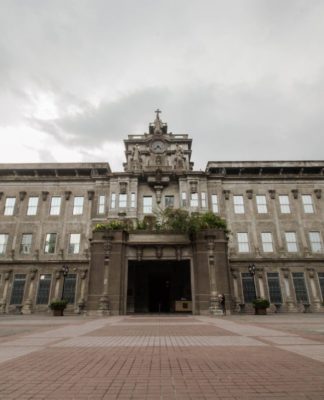 I WAS shoving sketch pads in my bag after discussing a book design proposal with Mr. Alejandro Consolacion II, titular organist of the Union Church of Manila, when he suddenly made a gesture for me to sit beside him in the organist’s chair of the pipe organ console. “I want to play something for you,” he said. I fumbled as I took the seat, careful not to touch any of the rather complicated knobs and switches of the console. We were at the choir loft of the Manila Cathedral in Intramuros and for the first time in my life, I was looking at the full majesty of the enormous instrument that is the Manila Cathedral pipe organ, the largest pipe organ in Southeast Asia.
I WAS shoving sketch pads in my bag after discussing a book design proposal with Mr. Alejandro Consolacion II, titular organist of the Union Church of Manila, when he suddenly made a gesture for me to sit beside him in the organist’s chair of the pipe organ console. “I want to play something for you,” he said. I fumbled as I took the seat, careful not to touch any of the rather complicated knobs and switches of the console. We were at the choir loft of the Manila Cathedral in Intramuros and for the first time in my life, I was looking at the full majesty of the enormous instrument that is the Manila Cathedral pipe organ, the largest pipe organ in Southeast Asia.
Mr. Consolacion started playing François Dubois’ Toccata in G Minor and in that instant, a glorious sound reverberated inside the cathedral, filling every ornate pillar and altar with the seeming glow of music. As the piece progressed, I forgot that I was listening to a pipe organ because the sound was comparable to that of a symphonic orchestra: vibrant, full and resonant.
The pipe organ is the ideal instrument for liturgical service, as it can fill a church with music. The tradition of the pipe organ has been with us since the 19th century. It is believed that the Spanish colonizers brought with them organ builders to construct pipe organs for the baroque churches they erected throughout the archipelago.
Most notable among these magnificent instruments is the organ of Las Piñas, said to be the only organ in the world whose pipes are made of bamboo. The virtuoso who spurred this innovation to adapt a European instrument to the Philippine tropical climate is a Spanish missionary from Graus (now known as Huesca, Spain), Fray Diego Cera Virgen del Carmen. He was the first parish priest of Las Piñas, serving between 1795 and 1830. The Las Piñas bamboo organ is dutifully maintained up to the present. In November of 2003, it was declared by the National Museum as a National Cultural Treasure for being the only 19th century bamboo organ in the country that has survived and is still functioning.
Unfortunately, not all of our historic pipe organs are well preserved as the bamboo organ. According to Diego Cera Organbuilders, Inc., a Filipino company that restores and documents pipe organs in the country, out of more than 200 Spanish pipe organs built between 1800 and 1900, only 14 remain, 11 of which can no longer play music. Most of these instruments met their demise through natural and man-made calamities, and most disturbingly, irresponsible church restorations and renovations.
Often, the poor organ was left to gather dust on the choir loft, the wood eaten by termites and metal parts tarnished by the elements.
Aside from the physical deterioration of these treasures, awareness and appreciation of the pipe organ and its music have declined. Not everyone can distinguish the sound of a real pipe organ from an electone. The fast pace of modernity and convenience have also contributed to this.
The restoration of a pipe organ is quite expensive so a parish would rather invest in an expedient electone and a synthesizer. Lastly, the music used in the liturgy no longer requires the traditional pipe organ sound. Parish priests would hesitate to restore their pipe organs because it is costly, and they have already been accustomed to contemporary liturgical music. Quality is not a concern.
On the lighter side, there are still churches that fervently propagate organ music. In Intramuros, the San Agustin Church and the Manila Cathedral hold annual music festivals to celebrate and promote their historic pipe organs. To emphasize that the pipe organ is in the service of the liturgy, the Manila Cathedral commissioned Misa Inmaculada Concepcion, a mass in Filipino with a set of four Marian hymns by Consolacion. It was written for congregation, cantor and choir with organ and optional brass and percussions. The aim of the project is to initiate new compositions intended to make use of the pipe organ as accompaniment. The composition also has a simplified version for unison congregation and keyboard in consideration to parishes without a pipe organ.
Notably, the bamboo organ church of Las Piñas holds the annual international bamboo organ festival in February, attracting foreign and local tourists, and music enthusiasts as well.
The pipe organ is a wonderful instrument. Its resonance reflects our sentiments, from happiness to sorrow, jubilation to grief. One way to discover this transcendence is to experience the music in itself. Let us begin by looking back and appreciating this treasure, our inheritance from our rich cultural tradition.
***
Jumpstart your appreciation of our traditional music by watching this year’s bamboo organ festival. The 34th Las Piñas International Bamboo Organ Festival will be on February 19 to 27 at the St. Joseph’s Church in Las Piñas. Some of the invited performers are the band Rivermaya and Filipino pride, Arnel Pineda, vocalist of the band, The Journey. Contact the Bamboo Organ Foundation Secretariat at 510-3839 for more details.
















